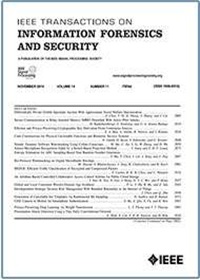Power Allocation and Decoding Order Selection for Secrecy Fairness in Downlink Cooperative NOMA With Untrusted Receivers Under Imperfect SIC
IF 8
1区 计算机科学
Q1 COMPUTER SCIENCE, THEORY & METHODS
IEEE Transactions on Information Forensics and Security
Pub Date : 2024-09-30
DOI:10.1109/TIFS.2024.3471429
引用次数: 0
Abstract
Non-orthogonal multiple access (NOMA) has been recognized as a promising multiple access technique for enhanced spectral efficiency in the current and next-generation wireless networks. In this paper, we examine a realistic NOMA model where users, assisted by a regenerative relay, cannot be fully trusted. We address the challenge of ensuring secure access for these users while accounting for the error propagation in successive interference cancellation (SIC) during the decoding process. For such, we formulate and solve two optimization problems, viz. maximizing the minimum secrecy rate of the users and maximizing the sum secrecy rate of the users, while accounting for SIC errors and the constraint on the power budget. For each case, we derive the optimal power allocation solution to achieve positive secrecy rates despite imperfect SIC. Simulation results provide key insights on the obtained secrecy rates and power allocations, factoring in residual interference. The joint optimal solution for the decoding order and power allocation is compared with different benchmark schemes: optimal decoding order and equal power allocation, fixed decoding order and equal power allocation, fixed decoding order and optimal power allocation, and optimal decoding order and channel-based power allocation. Our proposed framework demonstrates average performance gains of about 47.62 dB, 50.79 dB, 54.02 dB and 39.83 dB over these schemes and, hence, the fact that the proposed framework can substantially improve the secrecy performance.不完善 SIC 条件下具有不信任接收器的下行链路合作 NOMA 中的功率分配和解码顺序选择以实现保密公平性
在当前和下一代无线网络中,非正交多址接入(NOMA)已被认为是一种很有前途的多址接入技术,可提高频谱效率。在本文中,我们研究了一个现实的 NOMA 模型,在该模型中,用户在再生中继的协助下无法完全信任。我们要解决的难题是,既要确保这些用户的安全接入,又要考虑到解码过程中连续干扰消除(SIC)的误差传播。为此,我们提出并解决了两个优化问题,即最大化用户最小保密率和最大化用户总保密率,同时考虑 SIC 误差和功率预算约束。针对每种情况,我们都会推导出最优功率分配方案,以便在 SIC 不完善的情况下实现正保密率。仿真结果为所获得的保密率和功率分配提供了重要启示,同时考虑到了残余干扰。解码顺序和功率分配的联合最优解与不同的基准方案进行了比较:最优解码顺序和相等功率分配、固定解码顺序和相等功率分配、固定解码顺序和最优功率分配,以及最优解码顺序和基于信道的功率分配。与这些方案相比,我们提出的框架的平均性能分别提高了约 47.62 dB、50.79 dB、54.02 dB 和 39.83 dB,因此,我们提出的框架可以大幅提高保密性能。
本文章由计算机程序翻译,如有差异,请以英文原文为准。
求助全文
约1分钟内获得全文
求助全文
来源期刊

IEEE Transactions on Information Forensics and Security
工程技术-工程:电子与电气
CiteScore
14.40
自引率
7.40%
发文量
234
审稿时长
6.5 months
期刊介绍:
The IEEE Transactions on Information Forensics and Security covers the sciences, technologies, and applications relating to information forensics, information security, biometrics, surveillance and systems applications that incorporate these features
 求助内容:
求助内容: 应助结果提醒方式:
应助结果提醒方式:


